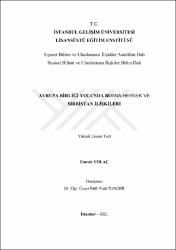| dc.contributor.author | Yolaç, Emrah | |
| dc.date.accessioned | 2021-12-07T13:01:00Z | |
| dc.date.available | 2021-12-07T13:01:00Z | |
| dc.date.issued | 2021 | en_US |
| dc.identifier.uri | https://hdl.handle.net/11363/3074 | |
| dc.description | Danışman: DR. ÖĞR. ÜYESİ FATİH FUAT TUNCER
Yer Bilgisi: İstanbul Gelişim Üniversitesi / Lisansüstü Eğitim Enstitüsü / Siyaset Bilimi ve Uluslararası İlişkiler Ana Bilim Dalı / Siyaset Bilimi ve Uluslararası İlişkiler Bilim Dalı
Konu:Siyasal Bilimler = Political Science | en_US |
| dc.description.abstract | Bölgesel entegrasyon, farklı ülkelerin bölgesel bir alanda ticareti serbest hale getirme politikaları izleyip ekonomik topluluklar oluşturmaları olarak tanımlanmaktadır. II. Dünya Savaşı'nın ardından 1960'lı yıllarda bölgesel entegrasyon artmaya başlamış; 1980'li yıllarda ülke ekonomileri büyümüş ve küresel rekabet yükselmiştir. Ülkeler içinde bulundukları rekabet ortamına birlikte karşı koymak ve Pazar verimliliğini arttırmak için bölgesel entegrasyona başvurmuşlardır. Avrupa Birliği 1957 yılında Roma Antlaşması ile Avrupa Ekonomik Topluluğu adı ile altı merkez ülkenin çevresinde kurulmuştur. Günümüze kadar birçok genişleme dalgası yaşayan birlik; savaşları barış ile sona erdirmeyi amaçlamış ancak zaman içinde amaçlarını değiştirmiştir. Birliğe üye ülkeler arasındaki gelişmişlik farkları birliğin önemli sorunlarından birini oluşturmaktadır. Bu sorunu çözümleyebilmek için Avrupa Birliği kurulduğu günden bu yana bölgesel politikalar ortaya koymuştur. Avrupa Birliği'nin bütünleşmesine inşacılık perspektifinden bakıldığında bütünleşmenin sadece ekonomik değil kimlik, norm ve kurumlar gibi unsurların da büyük önem taşıdığı görülmüştür. Postpozitivist bir yaklaşım olan inşacılıkla Avrupa Birliği bütünleşmesi çok boyutlu olarak incelenmeye başlanmıştır. 2000'lerde kendini gösteren ekonomik kriz, Balkan ülkelerinin ekonomik yapılarının kaldırabileceği türden olmamıştır. Bu nedenle; AB 2007 yılında başlayan Katılım Öncesi Yardım Aracı (IPA) aracılığıyla; Karadağ'a yıllık 40 milyon dolar, Sırbistan'a 200 milyon dolar seviyelerinde harcama yapmıştır. Avrupa Birliği'nin ekonomik entegrasyonu sağlamak için yaptığı bu hamle Balkan ülkeleri ve Avrupa Birliği arasında bağlılık oluşmasını sağlamıştır. Bu bağlılık sonucunda Balkan ülkeleri para birimlerini Euro olarak değiştirmiş veya Euroya entegre etmiştir. Balkan ülkelerinden Bosna Hersek ve Sırbistan 2003 yılında yapılan Selanik gündeminde sonra Avrupa Birliği'ne potansiyel aday ülkeler olarak katılmışlardır. AB Bosna Hersek'i bünyesine katarak kalıcı bir dönüşüm sağlamayı amaçlamıştır. Avrupalılaşma süreci Sırbistan'da birçok altyapısal sorunu gün yüzüne çıkarmıştır. Savaştan yeni çıkan Sırbistan için bu sorunlarla birdenbire mücadele etmek kolay olmamıştır. Avrupa yanlısı hükümetlerle birlikte vergiler artırılmış, ülke özelleştirmelere açık hale gelmiştir. | en_US |
| dc.description.abstract | Regional integration is defined as the different countries' following trade liberalization policies and forming economic communities in a regional area. II. After the World War, regional integration started to increase in the 1960s; In the 1980s, the national economies grew and global competition increased. Countries resorted to regional integration to coexist with the competitive environment they are in and to increase market efficiency. The European Union was established in 1957 under the Treaty of Rome, under the name of the European Economic Community, around six central countries. Unity has experienced many expansion waves until today; he aimed to end wars with peace, but changed his goals over time. The development differences between the member states of the Union constitute one of the important problems of the union. In order to solve this problem, the European Union has put forward regional policies since its establishment. When we look at the integration of the European Union from the perspective of constructionism, it is seen that integration is not only economical but also elements such as identity, norms and institutions. The integration of European Unionism with constructivism, which is a post-positivist approach, has begun to be examined in a multi-dimensional way. The economic crisis that emerged in the 2000s was not the type that the economic structures of the Balkan countries could handle. Therefore; Through the EU Instrument for Pre-Accession Assistance (IPA), which started in 2007; He spent $ 40 million annually on Montenegro and $ 200 million on Serbia. This move made by the European Union in order to achieve economic integration has led to a commitment between the Balkan countries and the European Union. As a result of this commitment, the Balkan countries changed their currencies to Euro or integrated them into the Euro. Bosnia-Herzegovina and Serbia, the Balkan countries, joined the European Union as potential candidate countries after the Thessaloniki agendo in 2003. The EU aimed to achieve a permanent transformation by incorporating Sona Herzegovina. The Europeanization process has raised many infrastructural problems in Serbia. It was not easy for Sudden Serbia to fight these problems suddenly. Along with the pro-European governments, taxes were increased and the country became open to privatization. | en_US |
| dc.language.iso | tur | en_US |
| dc.publisher | İstanbul Gelişim Üniversitesi Lisansüstü Eğitim Enstitüsü | en_US |
| dc.rights | info:eu-repo/semantics/openAccess | en_US |
| dc.rights | Attribution-NonCommercial-NoDerivs 3.0 United States | * |
| dc.rights.uri | http://creativecommons.org/licenses/by-nc-nd/3.0/us/ | * |
| dc.subject | Avrupa Birliği | en_US |
| dc.subject | Bosna Hersek | en_US |
| dc.subject | Sırbistan | en_US |
| dc.subject | European Union | en_US |
| dc.subject | Bosnia and Herzegovina | en_US |
| dc.subject | Serbia | en_US |
| dc.title | Avrupa Birliği yolunda Bosna Hersek ve Sırbistan ilişkileri | en_US |
| dc.title.alternative | Bosnia and Herzegovina and Serbia Relations on the Road to European Union | en_US |
| dc.type | masterThesis | en_US |
| dc.department | Lisansüstü Eğitim Enstitüsü | en_US |
| dc.relation.publicationcategory | Tez | en_US |



















